1860-1925
Early Amateur Baseball.- Baseball was probably introduced into East Liverpool by the soldiers who had returned from their various commands in the Civil war in 1865. Previously and subsequently the old game of town ball or "one, two cornered cat," which really was but a modified type of cricket was indulged in by those who hesitated to take the new arrangements of play.
Perhaps the first team ever organized in the city was that known as "The Bon Tons." It was an aggregation of clerks from the various stores and business houses in the community. This club drew the resentment of working men who formed many other teams. One known as "The Saggermakers" stood out in those days. Then there were the "Common Heights," "The Haymakers," "The Resolutes" and "The Little Champions." This latter was the first team formed by W. A. Calhoun and played first in 1873. Almost every vacant lot in the city was then utilized for the new game and many fine players were soon developed.
The first great team of the city was The Crockery City Club which was organized in 1876 by Eugene Bradshaw, who selected the stars of all of the other clubs in the city. It was the first team to really play at the West End park. W. A. Calhoun was the scorer for the club. To combat this team in 1878 the "White Granites" were formed by John Harvey and I. N. Crable, but was signally defeated by the older organization which remained dominant for fourteen years until 1890 when the Eclipse team which formed from the nucleous of players known as "The Redstockings" were taken over by G. Y. Travis. This aggregation was merged with the Crockery City outfit with Mr. Travis as manager and Mr. Calhoun as president and scorer. For four years thereafter it became the first East Liverpool team and as such played the best independent and professional clubs in the country and always to the financial good of the visitors, so well were the contests patronized.
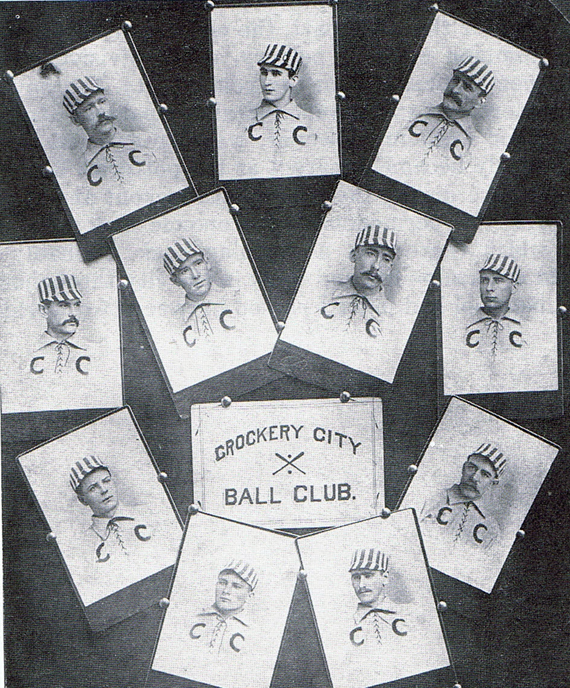
Baseball became the major organized team sport during the 1870's and 1880's in East Liverpool as well as the rest of the nation. It provided entertainment for thousands of fans while encoiuraging intense city rivalry.
In 1890 the team became a member of the Ohio valley league which compromised Steubenville, Wellsburg and two teams in Wheeling, W. Va., and the Beaver Grays of Beaver, Pa.
Before the season closed East Liverpool and Wellsburg contingents withdrew to play independent ball because the other clubs were not good drawing cards. W. A. Calhoun was the president of the league.
The Crockery City Club included the following players: Curtis, James and Willis Welch, Thomas and William Pickall, H. And R. Ashbaugh, Edward and William Smith, John, George and Bazil Rowe, John and George Tomlinson, Jerry and John Derrah, John and Charles Reark, Chal. Stewart, Frank Knowles, William Osteman, Thomas Wildblood, Charles Morrison, Owen Haley, William Russell, J. T. Howarth, Frank Allison, James Logan, William Moore, Richard Deekin, Frank Aul, William Baker, James Johnson, Phillip Hahn, Joseph Hagan, Charles Bean, Abner Lisby, William Bohn, John George, William Pfiel, Edward Sullivan, Daniel Miller, John Orr, Harry Carey, F. VanFossan.
The president of the club included Thomas Haden, William Manely and W. L. Smith, Sr.
James A. Calhoun managed the club in 1879 and 1880 during the absence of W. A. Calhoun in Indiana. Ed Geon, treasurer of the club for a long period, had charge of the team in 1885 when Mr. Calhoun was in Illinois. In 1887 Mr. Calhoun managed for a time the Columbus Association team, but returned in time to put the local club action at West End park.
The Eclipse team had among its leading players: John Daniels, Joseph and George Carey, Robert Cargo, Robert Westlake, C. And J. McShane, William Young, "Monty" Neeves, Charles and John Reark, William Carey, Alfred Shawn, Win Mercer, Charles Albright, William McNutt, John O'Brien and Robert Dunn. The two clubs were merged on Jan. 20, 1891. Thereafter G. Y. Travis was the manager and W. A. Calhoun scorer and publicity aid.
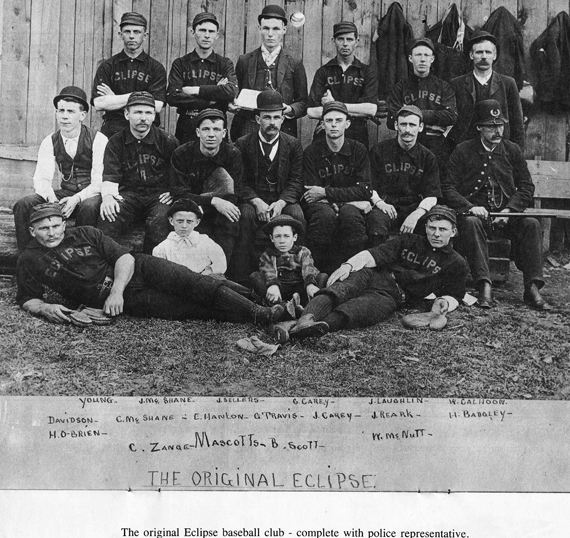
Following the activity of the Eclipse team and until the advent of the P. O. M. league much of the city's prestige on the diamond was looked after by a club that was foundationed by such capable performers as John Godwin, Thomas Cartwright, George McNicol, Harry Barker, Will Powell and others who had been veterans of the previous years of play.
Professional Baseball.- East Liverpool had seven years of experience in professional baseball, two of which, 1906 and 1907 in the "class D" Pennsylvania, Ohio and Maryland league and four, 1908, 1909, 1910 and 1911 in the "class C" Ohio and Pennsylvania league. Twice, in 1908 and 1909 the Potter outfit representing the city finished in second place. In all other seasons the club concluded in fourth place. Except perhaps in 1911-12 the team was always a pennant contender until the final contests were played.
In 1906 the East Liverpool Exhibition Company which G. Y. Travis was the president procured a franchise with Uniontown, Washington, Braddock, Pa., Cumberland, Md., Steubenville, O., and Charleroi, Pa., in the just organized P. O. M. League which was presided over by Richard Guy, a sporting writer of the Pittsburgh Gazzette Times. Joseph Wall, of Brooklyn, N. Y., a famed minor league player of the day was signed as the East Liverpool manager after Harry Tate, of Cumberland, Md., had refused it. The season began on May 15 and ended Sept. 15 of that year. More than fifty players were utilized during the season in an effort to land a winning combination.
Wall was supplanted as manager soon after the playing began by Perry Verga. In mid-summer a deal was made with the New Castles O. & P. League club by which its manager, Percy Steller and the team's captain, Alex. Sweeney, came to East Liverpool along with Kohle Miller, E. Crane and other men. Pat Eastley, "Lefty" Boyle and J. Hilbert the team was among the strongest in the circuit at the finish.
Other players utilized during the season were shortstop Zoellers, Verga, Allen, Kilheffer, Burke, Watson, James and Ross.

"Dutch" Myers, a local lad, was given an early tryout, but failed. He later played four years with the Brooklyn, St. Louis and Cincinnati National league teams and is now a minor league manager. Will Powell, another local player, who became a member of the Pittsburgh World Champions in 1909 and later played with Chicago, Cincinnati and numerous minor league clubs, finished the 1906 season as the first baseman of the East Liverpool team. In mid-yea also Thomas H. Stephans succeeded Mr. Travis as president of the clubs. All the games that year were played at West End park.
The race in 1906 was decided on the final day of the season when Washington, playing three games with Charleroi, won all of them and Washington and East Liverpool divided a double header. The results, due to a certain protested contests, made a tie at first place for Uniontown and Braddock which President Guy ordered to be decided by a playoff. Uniontown refused to play a post-series and the National Board being appealed to decided against the claims of Braddock. Of the 1906 East Liverpool players Otho Kruger was drafted by Kansas City, Eddie Pleiss by Pittsburgh and Pat Eastly by Wheeling, W. Va., at the close of the season.
The following year the P. O. M. Franchise was procured by C. A. Smith, of Chester, W. Va. Accordingly a fine ball park, modern two-story grandstand with bleacher seats along the first base line and back of left field were placed in the northeast section of Rock Springs park then the mecca for thousands of tourist during the summer months.
Tom Fleming, a heady minor league outfielder who had a brief service in the majors, was signed as manager. Zanesville was given the Cumberland, Md., franchise in 1907. Charles J. Bippus, a local theatrical man became the club's president and business manager. He had served in the latter capacity at the close of the 1906 season.
The club was strong all year. It finally had such pitchers as "Jack" Frill, a southpaw, later long with the New York Americans; "Sunny" Price, the old college star at short; Farabaugh, a nephew of Charles Schwab in the left field, then a law student and later an Indiana judge; Lord, brother of the Philadelphia American Lord, himself a minor league star second sacker; Ball, perhaps the speediest man in the league on the bases, who hailed from New England as did Conoroy, the slow-moving, but accurate and heavy-hitting stevedore from Maine on the first base. The other players on the club included Pitcher Kenworthy, a later Pacific Coast league manager, pitchers Wilhelm, Groomes, Boyle, Rarey; catcher, Alex Sweeney; third baseman, "Buzz" Netzell, later with Pittsburgh and long a Michigan league manager; McMahon, Bero, Peartree, L. Willig and outfielder Blake of the 1906 team.
Because former Manager Percey Stetter had taken over the direction of the Steubenville club and finally had with him Eddie Pleiss, "Lefty" Boyle and John Godwin, East Liverpool infielder, who had just concluded an engagement on the Boston American league club, the rivalry between the two Ohio river towns was intense. This was accentuated by the signing by Steubenville of "Stony" McGlynn, a pitcher so capable to serve for a long period thereafter with the St. Louis Nationals.
East Liverpool became a member of the O. & P. League in 1908. In the preliminary work thereto Manager Tom Fleming was given the city's P. O. M. franchise by President Richard Guy and by an individual coup he was thus given the club rights in the older organization. Later, after a period of negotiations, he transferred his holdings to C. A. Smith, of Chester W. Va. Mr. Bippus continued for a time in his old role as business manager. Finally Bill Phillips, of Charleroi, Pa., long a pitcher with the Cincinnati Reds and later twirler and assistant director of the New Orleans club of the Southern league, was procured as manager.
Manager Phillips finished second, next to Akron, in the race of that year. He had an outstanding aggregation of ball players. His pitchers were himself, his half-brother, Barney Wolfe, formerly of the New York Americans; Johnny Fisher, of Noblesville, Ind.; John Nolly, of Alabama; Catcher Rapp, of Washington, D. C. Worked behind the bat with Bob Tarleton, of New Orleans on first, Scraprion" Beecher sustained a fractured leg while sliding into second base with Woodruff, Gaston and Manning in the outfield. Kunkle, Mackey, Mcneil and Cooper were other men that filled in during a part of the season.
Phillips led the league in the pitching that year with 22 games won and but four lost. One of the outstanding performances of the season was the 16-inning battle which he won from Pitcher Clyde of the Sharon team on the Rock Springs field. Charles Morton, of Akron, was the president of the league in 1908.
Arch Osborne, of Charleroi, Pa., a pitcher, was the team's manager in 1909, Bill Phillips having taken over the direction of the Wheeling, W. Va., club of the Central league. Again East Liverpool finished in second place with Akron under Lee Fohl, winning the honors. The league president was Sam Wright, a newspaper man of Youngstown.
Besides himself Osborne had Jerger, Cefalu and McBride as pitchers with Hinton and McGinley doing the catching. John Raley was on first, Lattimore at second, Strood at third and Reagon, a southerner, at short. In the outfield were the hard hitting Curtis, of Wellsburg, W. Va., the youthful Shanks, of Monaca, Pa., who later spent nearly a decade with the Washington Americans and then went to Boston and New York and Hinton and Osborne himself alternating in the right field. Win Kinkaide was the club's business manager. The batting leader of that year was Shotten, of Steubenville, who afterwards went to St. Louis Americans. Manager Osborne was called to Wheeling to aid that team near the close of the season and John Raley led the Potters in the finish.
The season of 1910 began on May 5 and ended Sept 5. The Potters were directed by Guy Sample, of Jackson, Miss. Early in the season President Sam Wright passed away. J. H. Maxwell, vice president, headed the league the remainder of the season.
East Liverpool won 63 and lost 61 contests that year and made a tie with McKeesport for third place.
Manager Sample, John Hinton and Connell were the 1910 catchers with Warrender, who led the league in hitting that year, Ralton and Shanks in the garden positions, John Roley on first, Ralph Lattimore on second, Wright at short and Doran at third. Curt Bales Byers, Monahan, pitchers. Others were added during the season. Sample was finally supplanted by Ralph Lattimore, who finished the year as the club's pilot.
In 1911 the O. & P. League was presided over by George L. Moreland, baseball statistician, of Pittsburgh. C. A. Smith gave up the franchise which he held in the organization and a local company, headed by J. C. Sims, newspaper publisher, sponsored the East Liverpool Club which was managed by the veteran catcher, Alex. Sweeney and the games, as in 1906, played in the West End park. The players of that year included: John A. Aiken, Jesse F. Page, William Taylor, Howard Lewis, George Burns, Prescott C. Negly, Oliver A. Miller, Thomas Silcox, Dan McAleese, Scott Peckwell, Robert Covart, Frank Doyle, W. A. Hooper, Joseph Terson, Max Schubert, John J. Cutter, Abe Kruger, Gray, Wilson, Lentz, Cavanaugh, Thompson, McAvoy and L. Richey, the latter two being East Liverpool natives.
Towards the end of the season the club was strong and playing fine ball.
East Liverpool had its final professional baseball team in 1912 when the city was a part of the O. & P. League of that year which failed by a few days to finish the season following the loss of club after club on it.
The league began with McKeesport, Sharon, New Castle and Connellsville, Pa., and East Liverpool, Salem, Alliance and Steubenville, O., as members. G. Y. Travis, of East Liverpool was president of the organization. An attempt was made to function with a salary limit of $1,200 and the presence of but 12 men on each team.
Most of the teams had outside promoters who failed to attract local patronage and eventually they gave up their franchise. East Liverpool formed a local company with Lyman Rinehart as president and John Williams as secretary. Tony Crane, of Scranton, Pa., who had played first base with great ability for the Erie O. & P. Team in former years was procured as manager. Before the season was very old he gave way to Outfielder Donnelly who directed the club until it ended its activities. More than 50 players of all degrees of ability were tried out at the start of the season. These included George Porter, a Lisbon High School lad who played second base for some time for the club; Pitcher Northup, who later made a great record in the American Association; Pitcher Leisure, T. Taylor, A. L. Behhylem, H. L. Pittinger, F. G. Stage, Catcher William Bayland, a local lad, Catcher McWilliams and many others. Towards the end of the season veteran, Percy Rising, Fisher Dedon, Mackert, Goff, Cardinal and others were secured.
The Season was divided into two halves the first of which Salem won handily. On June 19 New Castle and Connellsville were dropped from the league. In the losses and addition of clubs made of it a four-club circuit with East Liverpool, Sharon, Steubenville and Fairmount, W. Va., as members finished.
In the final days of August an attempt was made to transfer the East Liverpool club to Pittsburgh, but after playing one game there the players returned to the Pottery city and disbanded, Several of them finally finished the season with other league teams elsewhere.
A significant feature of the league activities in East Liverpool was that Mal Myers, of Jethro, joined the final professional club that the city had in its closing days while Harry "Dutch" Myers had been a member of the first professional team that represented the city in 1906 during the early part of that season.
During 109-10 the Tri-State Trolley league composed of teams from Klondyke, Pleasant Heights, Dixonville, Northside, East End of East Liverpool and Chester, W. Va., functioned. It was made up entirely of amateur players.
Industrial League Contests.- Following the close of professional ball in the city was the formation of numerous pottery baseball clubs in and about East Liverpool. An outstanding contest of such clubs was the famous clash of the Knowles, Taylor and Knowles and Homer Laughlin teams in 1915.
The series of three games arranged was for a $500 purse and the entire gate receipts. Two were played at Rock Springs park, the first on Wednesday after Labor Day of that year and the second the following Saturday, both being won by the K. T. K. club by the same score, 4 to 2. The first of these stood 1 to 0 in favor of Laughlin until the eighth inning when the score was tied and the contest prolonged to the thirteenth inning. Then Laughlin made three runs in their half K. T. K. One in their final batting period. Earl Saulsberry and Harry Vincent formed the Laughlin battery while Chalres Rigby and John Panavan were at the points for K. T. K. More than 3,000 persons witnesses the final contest.

During the same period following the close of league baseball in East Liverpool a club was maintained at West End park to play independent ball for two or three seasons by Rex McConnell. It gave way to the Man-Of-War Club, managed by Edward Mullin which in turn gave way to the Eagles' nine which was directed by J. W. Fowler.
In 1921 an industrial department was formed by the Y. M. C. A. Of East Liverpool which directed an eight-club circuit of teams made up of players representing various potteries and industrial plants in the city. What approximated a "baby world series" followed the close of all but the first of these seasons which was divided in two halves, the first closing on July 1 approximately and the second on or about Labor Day of each year. The standard of playing increased annually with the development of younger players and the addition of those who had had experience with other clubs.
In 1925 the Y. M. C. A. eliminated the industrial arm of its activities and the ball players thrown on their own resources, formed an organization known as the City Industrial league of which C. C. Cline, a clothing merchant and former player in his Maryland home became president, T. T. Jones, secretary-treasurer and Lee C. Cooper a member of the so-called "Board of Strategy" which from time to time aided in the league's doings. Despite a bad start the teams composing it, Homer Laughlin, Chester, W. Va., Wellsville, Knowles, Taylor and Knowles, Babcock and Wilcox and Trotter's Chrevolet, played such a high grade of ball, due to the fact that each aggregation signed its own players from among the best talent available, that what approximated a rennaissance in the diamond in and about East Liverpool occurred. Attendance was marked at practically all of the contests and on crucial occasions reached figures of more than 5,000 persons. The first half championship was won by the Chester team directed by the mayor of that city, Frank Riley, and the second by the Homer Laughlin Club of Newell, W. Va., managed by Saul McCoy. In the "baby world series" that followed, Chester won four of the five games played with Homer Laughlin, which attracted people for miles around the city. More than 1,000 automobiles surrounded the playing field in some of these last contests-an unprecedented feature of games previously played in the Pottery City locality.
During the Y. M. C. A. Period of activity with the Industrial baseball league, W. T. McNutt was the organization's president in 1922-23 and Don Trotter succeeded him in 1924. William Ashbaugh during all these years was the leagues secretary and W. J. Scott was the Y. M. C. A. Industrial secretary.
East Liverpool in Major Leagues.- Curtis Welsh played with the Crocker City team in 1877, '78, '79, '80, '81, '82. Then he was sent by Manager W. J. Calhoun to Toledo where he played two years. He went to St. Louis in 1885 and remained there for three consecutive years as a member of the great St. Louis Browns, owned by the famed Cris Von Der Ahe and managed by Charles Comisky. Welch became the "world's Campion Fielder." he was finally sold to the Philadelphia Americans and finished his career with the Cincinnati Nationals. He passed away in East Liverpool in 1896.
Of these players George Carey and Alfred Shaw subsequently made the Baltimore teams of the National league and the Boston Red Sox of the American league. Carey was for a year with the Baltimore Orioles managed by Ned Hanlon and on which were Manager Muggsy McGraw of New York, Wilbert Robinson of the Brooklyn club and Hugh Jennings of the Detroit and New York teams. Carey started out with the Altoona, Pa., and Shaw with the Wilkinsburg, Pa., club. Carey became known as perhaps the best fielding first baseman of his day in the major leagues.
Win Mercer, after a start with the Fall River, Mass., team, landed with the Washington Americans where he was a pitcher for many years before going to Detroit which club he had signed to manage in 1904, but he passed away in California the fall previous while directing an All-Star, major league club in a series of barn storming contests at the close of the 1903 season.
John "Jack" Darrah had a brief trial with the St. Louis Browns following a previous and subsequent period of outstanding success as player and manager in the minor leagues. He directed teams in Wheeling, W. Va., Springfield, Steubenville, Uhrichsville and Canton, O., and Portland, Ore., in all of which place he sustained a reputation for aggressiveness that has had few equals in the history of the game.
John Goodwin, starting out at Bloomington, Ill., made the Boston Red Sox for a couple of seasons in 1905-06 as third baseman. He later played in several minor league clubs. Harry Barker played for six years as a pitcher on the Bloomington Club.
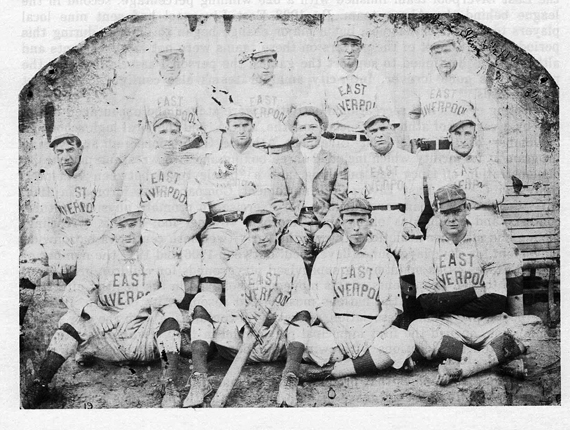
The 1907 East LIverpool "Potters" Class D professional baseball team played in a league encompassing three states.
Will Powell, basketball star, also got his baseball start as a pitcher on the Bloomington, Ill., team. He later became a pitcher with the Springfield team of the New England league and was in 1909 a member of the Pittsburgh Pirates which season the club won the world's championship from the Detroit Americans. Powell was later with the Chicago and Cincinnati National league clubs and with the Kansas City and Milwaukee teams of the American Association. He also played in the Southern Association. Powell and Welch were the only East Liverpool players to become members of the World Champion clubs.
Harry "Dutch" Myers became a member of the Brooklyn Nationals for several years and in 1922 the club won the championship but lost the world series honors to the Cleveland Americans. He started out with the East Liverpool P. O. M. Team and later went to the Scottdale team of the P. And W. Va., league from where he went to Sioux City, Iowa. From Brooklyn he was sent to St. Louis in 1924 and then for a period to Cincinnati. He finished the 1925 season as the manager of the Syracuse club of the New York state league.
William Mundy, after a period in the Virginia and other minor leagues, became a member of the Boston Red Sox of the American league in 1911. He later played with various minor league clubs. Returning to East Liverpool he played much independent ball and managed clubs in the Y. M. C. A. City Industrial league and played on the City Industrial league clubs.
In 1925 following his constantly increasing form as an outfielder in the Y. M. C. A. City Industrial league, Raymond Buzzard, an East Liverpool law student at Western Reserve University in Cleveland, was signed by the Cleveland American league club for a 1926 trial at the conclusion of his school year.
West End Park-Patterson Field.- West End Park was first laid out as a ball ground in may of 1876.
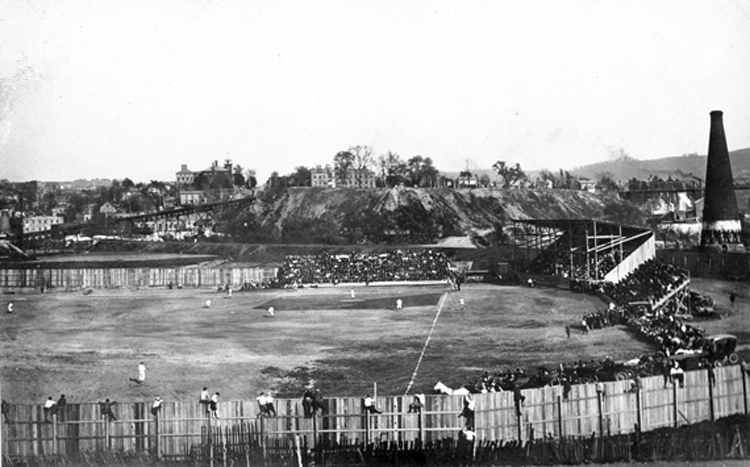
West End Ball Field
The Crockery City crack players, managed by Eugene Bradshaw, used it. William Calhoun was the official scorer that year. The next year permission was granted by the owners, Messers Hill, Brunt and Bloor to build a grandstand on the plot. Mr. Calhoun assisted in this undertaking also. In 1882 this was torn down and a large ediface of the same kind placed in its place but this structure was destroyed in the great flood of 1884. In 1887 Mr. Calhoun having returned from managing the Columbus team of the American Association assisted in the building of still another new stand which stood until about 1904 when the one used at the beginning of the P. O. M. League in 1906 was erected. This one finally went into decay and was torn down and the present one placed in circular position in 1922.
In the fall of 1923 Monroe Patterson purchased West End park and presented it to the East Liverpool High School for undergraduate athletic activities which included baseball, football and track events. Permission was also granted other East Liverpool aggregations needing it when not in use by the members of the high school with the single stipulation that no admission prices could in any manner be charged on Sunday which requirement has eliminated the playing of Sunday baseball and football within the city limits.
For the benefit of football players a dressing room was erected at the East End of the grandstand at Patterson Field in 1924. Immediately after his purchase of and presentation to the high school of the old West End Park Mr. Patterson and the Board of Education began filling the plot so as to place it above a flood stage. In 1925 this work was being continued with much new ground made on the north section of it. History of Columbiana County, Ohio – Vol I, Harold B. Barth Historical Publishing Company 1926. CHAPTER XX SPORTS AND RECREATIONS
Ghosts of Patterson Field
1905-1912
The Ohio and Pennsylvania Baseball League
http://rockspringspark.blogspot.com/2012/05/o-baseball-league.html
1910-1930
East Liverpool was represented in both baseball and basketball semiprofessional leagues during this period. The Ohio and Pennsylvania Baseball League, which had an East Liverpool team for years, disbanded following the 1912 season. A new independent club was organized for the next season. Known by a variety of names, including the "Man 0 War team," they played rivals from a five-state area throughout most of the 1920s. Frank D. Allison sponsored a basketball team in the city and was able to obtain a franchise in the American Basketball League in 1925. The East Liverpool team joined Cleveland and Canton as Ohio's representatives in the league and Allison recruited seven "proven stars of national prominence" from eastern cities. Although spectators enjoyed the games played in the city, identification with a local team was missing. [The City of Hills and Kilns, pp. 305-06].
Some Baseball at Rock Springs Park
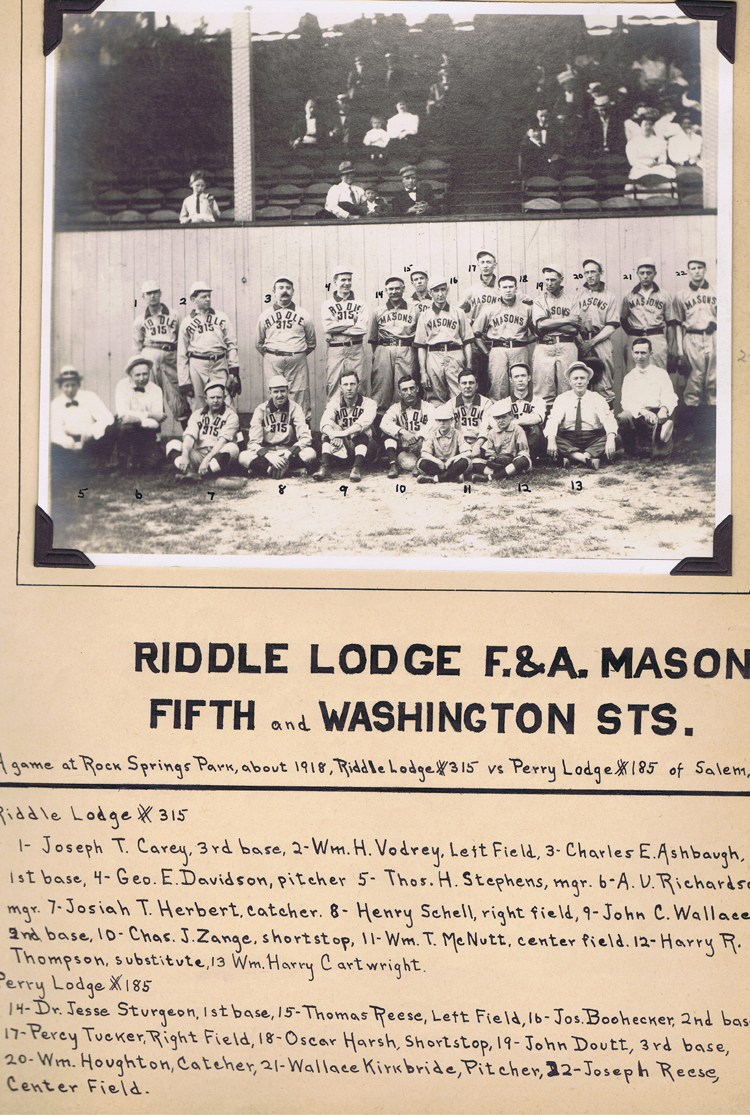
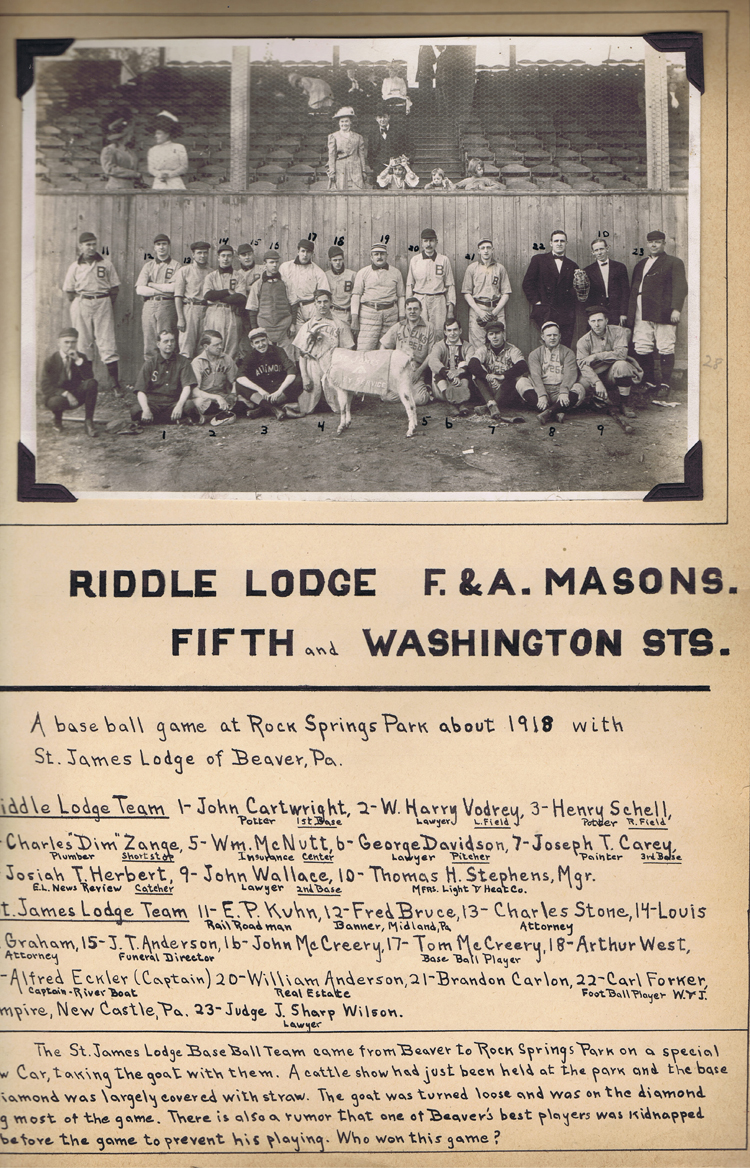
This site is the property of the East Liverpool Historical Society.
Regular linking, i.e. providing the URL of the East Liverpool Historical Society web site for viewers to click on and be taken to the East Liverpool Historical Society entry portal or to any specific article on the website is legally permitted.
Hyperlinking, or as it is also called framing, without permission is not permitted.
Legally speaking framing is still in a murky area of the law
though there have been court cases in which framing has been seen as violation of copyright law. Many cases that were taken to court ended up settling out-of-court with the one doing the framing agreeing to cease framing and to just use a regular link to the other site.
The East Liverpool Historical Society pays fees to keep their site online. A person framing the Society site is effectively presenting the entire East Liverpool Historical Society web site as his own site and doing it at no cost to himself, i.e. stealing the site.
The East Liverpool Historical Society reserves the right to charge such an individual a fee for the use of the Society’s material.